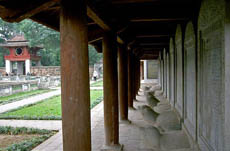The United Nations’ Educational, Scientific and Cultural Organisation (UNESCO) is considering giving documentary heritage status to 82 doctor laureate steles at Hanoi’s Temple of Literature.
 The Temple of Literature’s director Dang Kim Ngoc said the proposal was part of a worldwide programme, Memory of the World, to document heritage.
The Temple of Literature’s director Dang Kim Ngoc said the proposal was part of a worldwide programme, Memory of the World, to document heritage.
The 82 stone steles are carved with the names of 2,313 doctors who passed the court examinations between 1442 and 1779 (some material recorded the period between 1484 and 1514) under the Early Le, Mac and Late Le dynasties.
The steles, which bear the names of Trang Nguyen, Bang Nhan, Tham Hoa, Hoang Giap (the first, second, third and fourth winning categories at the royal competition), sit on top of stone turtles.
The UN’s final proposal should be completed by September, which considering the mount of research on the steles over many years, should not be difficult, Ngoc told Vietnam News.
The steles are different from those in other Asian countries, including China, which influenced Vietnamese feudal education.
The steles are mainly rectangular parallelepipes (a polyhedron consisting of six faces that are parallelograms) while the Chinese have varied forms, including square parallelepipes and cylinders.
The decorative patterns on Vietnam’s steles are more diversified.
“Each of the steles at the temple can be considered as a perfect sculptural work,†he said.
“The characters and meanings in the steles are highly regarded for their literature and artistic thought.â€
UNESCO has suggested changing the proposed title of the artifacts from Doctor Laureates steles at Vietnam’s Temple of Literature to 82 Doctor Laureates Steles of Le and Mac dynasties.â€
The Temple of Literature was founded in 1070 as a Confucian temple. Parts of the complex date to the earliest period, although much of the architecture dates from the Ly (1010-1225) and Tran (1225-1400) dynasties.
In 1076, Vietnam’s first university, the Quoc Tu Giam or Imperial Academy, was established within the temple to educate bureaucrats, nobles, royalty and the elite.
The university functioned from 1076 to 1779. The doctor laureate tests were extremely difficult, so few students passed. Each year, the names of those who did were engraved on the steles.